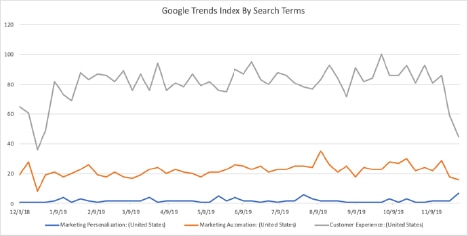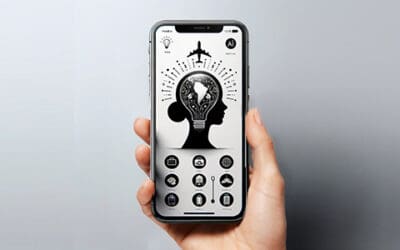
2020: The Year of Deep Personalization
Deep Dive. It started as a plunge into an activity and it has significantly evolved in the last 30 years. “Deep” is now associated with almost anything and everything involving a need for thorough examination — Deep Learning, and Deep Fakes as examples. That doesn’t mean it’s bad. It means we’ve moved beyond the surface of a subject and we are finding ways to question more, examine more and realize more opportunities. That said, I believe 2020 will be a tipping point year for personalization. Better yet, Deep Personalization.
We have finally gotten to a point where Artificial Intelligence, machine learning and marketing technologies in general can slice and dice data to create a very deep level of personalization. To what end you might ask? The holy grail of business: the customer experience. During the last few years the term “customer experience” has come into play. Just look at the search analysis I conducted in the chart below. You can also do a search term analysis for it against any other marketing phrase and you’ll see my point.

The only way an organization can achieve a customer experience that is sync with each customer’s desires is through Deep Personalization.
This level of personalization has no finish line. LighthousePE has been working on it for years. The thing we have learned is that there is always a new behavior and a new learning each day. Just think about your own life. Every experience, every interaction changes you. To personalize anything means you’re always trying to hit a moving target. To that end, there are things you need to do or watch out for if you are going to be successful at personalization and delivering on the ensuing customer experience.
Create a customer behavior data set.
If your goal is to deliver the best and most personal customer experience possible, you will need some type of customer data platform. Specifically, one based on the behaviors exhibited by each customer and one that is continually learning through AI or machine learning. It should also cut across the enterprise. Having a connected enterprise doesn’t mean only bringing in data sources from different departments. It also means including customer variables such regionality, seasonality and product cycle, etc.
Deliver personalized customer experiences with an emphasis on privacy.
Data collection and privacy is a tricky balancing act. Just ask Facebook. For brands to succeed they need to inform their customers just what they are collecting from them in terms of data and what they plan to do it. The opportunity here is to involve the customers in the process and provide them an outcome of that data collection, which is of personal value to them. In short, you have to be transparent and you need to give up some control.
Predictive analytics is the key to facilitating new behaviors.
Your data isn’t just a bunch of numbers; it’s your customers exhibiting their behaviors. By understanding the correlation between behaviors, you can create a predictive structure for new behaviors to occur. Each new behavior will add to the overall customer experience.
Having a customer experience mindset and a get-to-know your customer attitude is critical. By employing a system of examining past behaviors, designing a customer experience around new behaviors while also predicting future behaviors is the only way to outsell your competition. All of which falls under a need for, you guessed it, Deep Personalization.
You may also be interested in
Most Mobile Apps Don’t Make Money. Here’s Why.
Most brands believe their mobile app is making them money, when in reality, it probably is not. After all, when customers use a brand’s mobile app to complete a transaction, it doesn’t necessarily mean the mobile app is responsible for the transaction. It’s the...
Leveraging Artificial Intelligence (AI) to Uncover Sales Opportunities
Businesses are constantly on the lookout for innovative ways to maximize their revenue. Two of the most powerful sales techniques are cross-selling and upselling. Both strategies involve offering additional products or services to a customer during the sales process,...
How Adding True 1:1 Personalized Content to Your Mobile Marketing Can Generate Immediate ROI for Your Business
Personalized automated mobile marketing is more accessible and affordable than most business owners realize. It’s not just for large corporations anymore. It’s available for businesses of all sizes. With LighthousePE, your business can deliver deeply...
Personal AI Travel Itineraries Can’t Fully Deliver on the Promise of Personalization
Generative AI creates travel itineraries based on what everybody else has done, not what you’d like to do. The travel and tourism industry is all about inspiring people to have meaningful, memorable experiences when visiting a destination. Destination...





